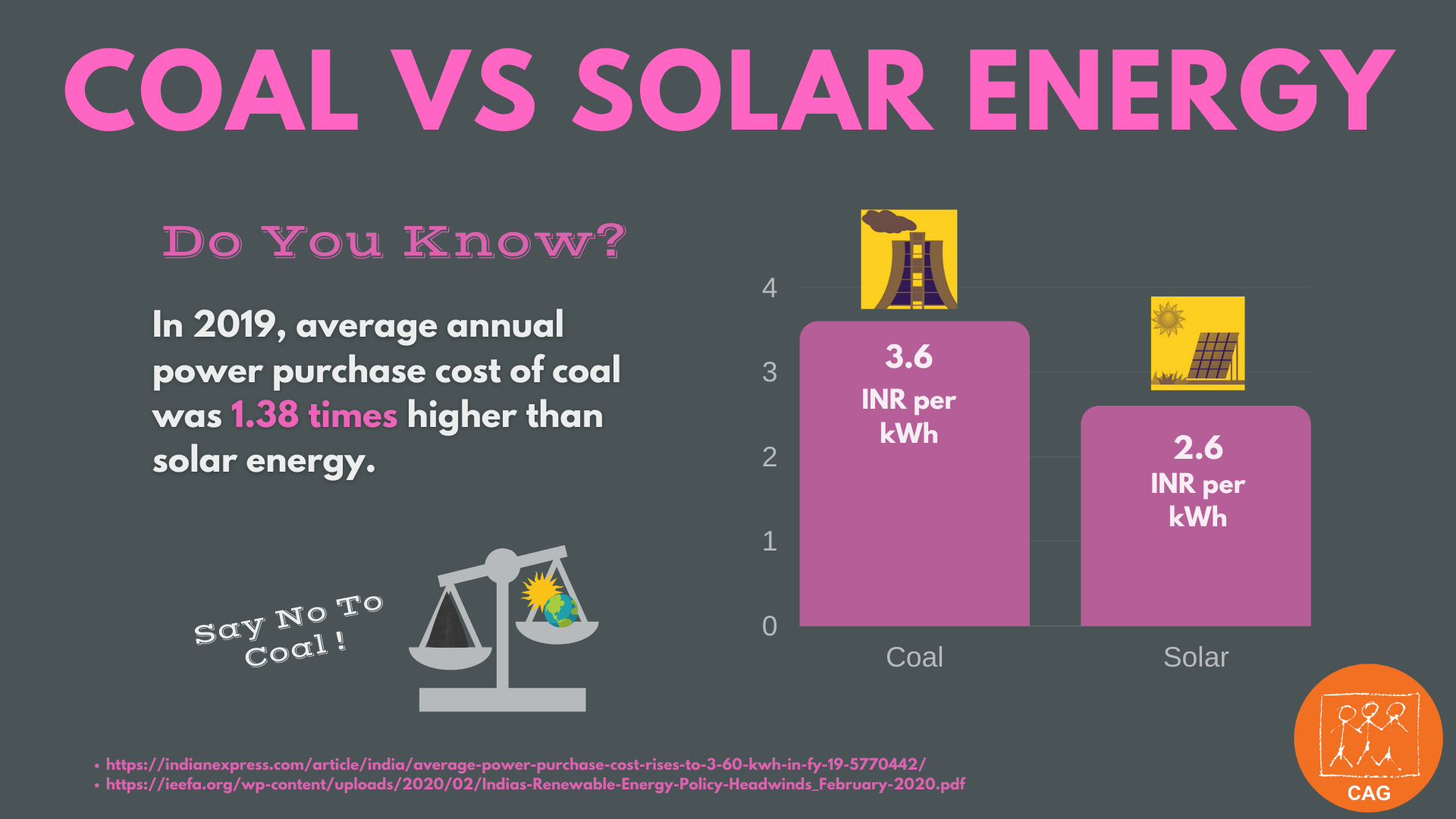Introduction
Do we suffer from a “coal addiction”? India used coal for more than 50% of its energy production as on October 31, 2020. According to the NITI Aayog coal will have at least a 44% share in energy mix even in 2040. The continuous use of coal as an energy source pollutes air, water and soil, with major effects being shown on the health and livelihood of local communities surrounding coal power plants. Also, coal-fired power generation is a significant source of greenhouse gas emissions and a major contributor to climate change.
To achieve its pledge of a 33-35% reduction in “emissions intensity” of its economy by 2030 from 2005 levels, India should not decide to invest in any unsustainable, untested and expensive solutions such as CCUS (Carbon Capture Utilisation and Storage). Experience from the other countries have shown that these technologies are bound to fail and another important factor to take into consideration is that opting for these technologies is only going to prolong our dependence on coal power. In addition to this, rethinking and reevaluation should be done regarding the addition of new coal mining areas as the tariffs for solar energy have hit all time low.
What are the impacts of coal?
- Groundwater depletion: From mining to combustion, coal-fired power generation is a highly water-intensive process. The World Resource Institute (WRI) has reported how weaker reporting mechanisms and non-compliance with MoEFCC’s Notification, 2015, is deepening the water stress issues in India. In Tamil Nadu, the increase in the number of coal thermal power plants between 2009 and 2017 went hand-in-hand with declining groundwater levels by as much as twelve times.
Figure 1: Coal infographics, Coal Vs Groundwater
- Health crisis: It affects the health of local communities by polluting the surrounding environment. The Particulate Matter (PM) pollution from coal-fired power plants had an estimated total health cost of 42,790 crores of Indian Rupees in 2011-12, which is found to be 0.47% of health cost fraction of India’s GDP (Gross Domestic Product) in the same year. It is also analysed that the health cost fraction of India’s GDP had jumped up to 2.68% in 2018-19 in keeping with decreasing PLF (Plant Load Factor) of coal power plants in India.

Figure 2: Coal infographics, Coal Vs Your Health
- Dominates energy sector: Coal is a low-cost energy source, which explains its popularity. Solar energy is cleaner in several aspects and should be made the more attractive option to end-users. Such a shift is seen in recent times with coal becoming a slightly more expensive energy source to procure than solar energy. For instance, in 2019, the coal based energy tariff was 3.6 INR per Kilowatt hour and the solar energy tariff was only 2.6 INR per Kilowatt hour.

Figure 3: Coal infographics, Coal Vs Solar Energy
- Air pollution: Coal power plants are responsible for 60% of particulate matter released from the industrial sector in India.The non-compliance with MoEFCC’s emission-norms as of 2017 by many coal power plants has resulted in reduced air quality in their surrounding areas.

Figure 4: Coal infographics, Coal and Air Pollution
- Water pollution: The spillage and the leachate from coal slurry into the surface and groundwater in the surroundings of coal power plants and coal mines pollute them with heavy metals, other contaminants, and nutrients, leading to the eutrophication of water. This not only affects the quality of groundwater and river water available for the local communities residing around coal mines and coal thermal power plants but also marine life, and livelihoods such as fishing and farming.

Figure 5: Coal infographics, Coal and Water Pollution
- Land pollution: Around 40,000 hectares of land is utilised for coal ash disposal in India. This coal ash contaminates the soil in the surroundings of coal thermal power plants and coal mines by leaching heavy metals like Cu, Ni, Pd and Zn way beyond the acceptable levels suggested by WHO (World Health Organisation). Thus, the extension in coal mining areas and rising coal power plants will further increase the environmental burden in India.

Figure 6: Coal infographics, Coal and Land Pollution
Why should coal usage end?
The rising coal consumption has increased our dependence on imported coal, which is planned to be reduced by a fast-track mining clearance for domestic coal in India. However, this decision is going to further enhance the burden on the environment and affect the livelihood and health of communities residing in their surrounding areas. Additionally, the increasing numbers of coastal coal power plants in Gujarat and Tamil Nadu run the risk of damage from rising sea-level; increase in natural disasters due to global warming and climate change. Therefore, it is imperative that we switch from coal based energy to renewable power, and improvise on energy efficiency in India to abide by the Paris Agreement for keeping global temperatures from rising more than 1.5℃ above pre-industrial levels by 2030.
Figure 7: Production and consumption of coal in India in million tons
(Sources: Coal Directory of India and Central Electricity Authority)
Conclusion
All data to date suggest that India does suffer from a coal addiction. While quitting coal use is the best way to reduce the effects discussed above, like with any addiction, it is not as easy as it sounds. India will parallelly require a shift away from fossil-fuel use and towards renewable energy and energy conservation. Along with the system-level changes, an individual’s actions should have a shift as well. Smart consumer decisions like installing rooftop solar panels and using energy-efficient devices in residential/commercial spaces will help in reducing the energy demand from coal and its subsequent, hazardous impact on the environment and the health of people. This must go hand in hand with the framing and implementing of policies to manage energy efficiency and deep decarbonisation of the energy sector.